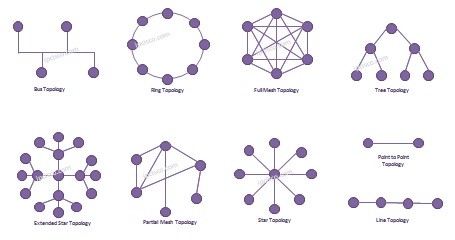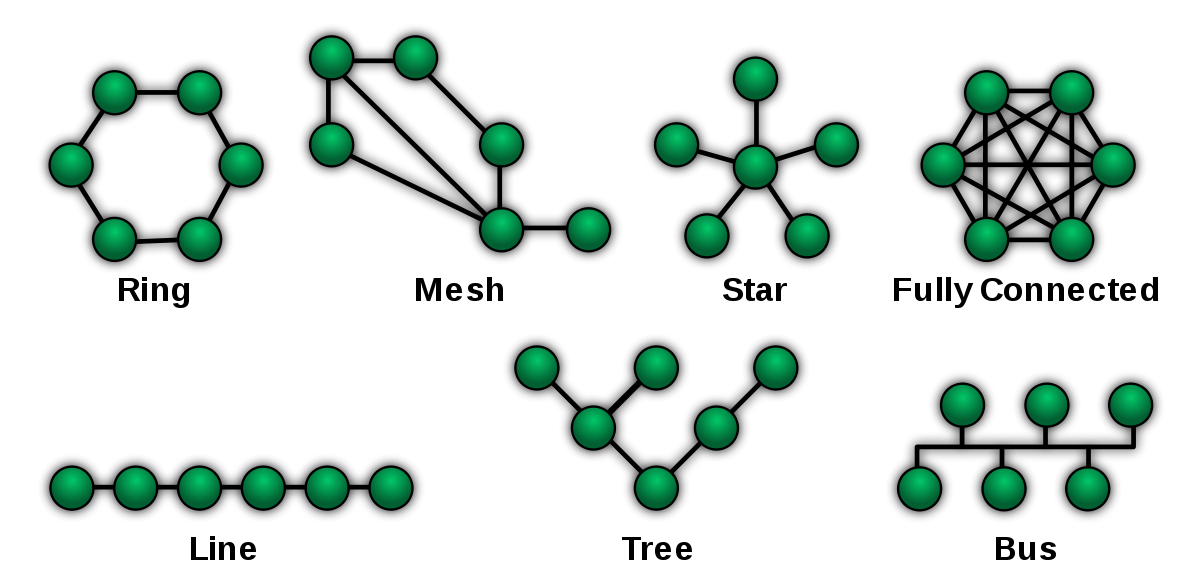11 Which of the Following Are Standard Network Topologies
A network technician has created a network that consists of a router a firewall a switch and several PCs. Each node is connected to two nodes.
Network Topology Tia S Glossary Of Telecommunication Terms
Extended Service Set ESS networks.

. Infrastructure Mode With infrastructure mode wireless clients interconnect via an AP. Types Of Network TopologieS Heres a list of the different types of network topologies. The local area network has three main topologies they are the star bus ring and other topologies are hybrid and mesh topologies.
Network Topologies Explained with Examples This tutorial explains network topologies Bus Star Ring Mesh Point-to-point Point-to-multipoint and Hybrid in detail with their advantages and disadvantages. All nodes are connected to the same link. Although there are many ways to configure network components a few of them have emerged as the most common and standard network topologies used in many different kinds of systems especially in smaller local area networks LANs.
Which of the following are standard network topologies Select three A Bus B Star from NET 110 at Rowan-Cabarrus Community College. With the ubiquity of wireless networks mesh topologies are now common. The physical topology describes the way computers connect with the help of cables whereas the logical topology describes the way the data flow from one computer to another within a computer network.
Network Topologies Topology -Physical and logical network layout Physical actual layout of the computer cables and other network devices Logical the way in which the network appears to the devices that use it. Point-to-point topology Daisy chain topology Bus topology Start topology Ring topology Mesh topology Hybrid topology Tree topology In the following sections well take a deeper look at each of the different types of topology. The layout and connections between network nodes.
The network has to be cost effective and easy to extend and implement. Bus topology is a network type in which every computer and network device is connected to single cable. One of them isnt Connect.
Furthermore the client wants his workstations connected by a single cable. Partially connected network D. Network Topology is the schematic description of a network arrangement connecting various nodessender and receiver through lines of connection.
All nodes are connected to the same link. Bus ring star mesh and wireless. Let us look at the advantages different network topologies offer and their shortfalls.
Tree structured network C. There is how-ever a big difference between a physical network topology and a logical network topology. Independent Basic Service Set IBSS networks.
Bus Topology Advantages of Bus Topology. The physical network topology represents how the network looks to the naked eyein other words the way the components are arranged. Networks designed with this topology are usually very expensive to set up but provide a high degree of reliability due to the multiple paths for data that are provided by.
Bus topology In this topology all computers connect through a single continuous coaxial cable. Which of the following distributed network topologies is impractical due to high installation cost. A bus network topology.
Network topologies describe the ways in which the elements of a network are connected. These networks use a basic building block the 80211 standard refers to as a BSS providing a coverage area whereby stations of the BSS remain fully connected. This cable is known as the backbone cable.
Infrastructure mode and Independent Basic Service Set IBSS. The 80211 standard supports the following two topologies. Synchronous Optical NETwork SONET is the standard topology for fiber optic networks.
Bus View Answer Answer. Which of the following network topologies should you use. Tree structured network C.
In a star topology every individual network device is connected to a central hub. A fully connected network complete topology or full mesh topology is a network topology in which there is a direct link between all pairs of nodes. Each node is connected to a central node.
When it has exactly two endpoints then it is called Linear Bus topology. A star network topology. Network Topologies Ethernet Standards Chapter Exam Take this practice test to check your existing knowledge of the course material.
Network Topologies Basically a topology is a shape so a network topology is the shape of a network. IBSS is also knows as ad hoc mode. A mesh network topology.
The 80211 standard identifies two main wireless topology modes. Bus topology ring topology star topology mesh topology and hybrid topology are examples of topologies. D Latest N10-007 Dumps Valid Version with 601 QAs Latest And Valid QA Instant DownloadContinue reading.
All other options are incorrect because they are LAN topologies not WAN topologies. They describe the physical and logical arrangement of network nodes. A ring network topology.
Partially connected network D. Which of the following physical network topologies was createdA. Use the 19216810024 network address to provide addresses to the network devices and then design a new addressing scheme to support the.
In a fully connected network with n nodes there are direct links. Developed in 1980s SONET can transmit data at rates of up to 25 gigabits per second Gbps. Network Topology B The network topology from Part 1 has expanded to accommodate the addition of router R3 and its accompanying network as illustrated in the following topology.
It is easy to set up handle and implement.

Network Topologies Bus Ring Star Tree Line Mesh Ipcisco

6 Best Network Topologies Explained Pros Cons Including Diagrams

Network Topology Types With Diagrams Ucpl Nextg Communication Provider
No comments for "11 Which of the Following Are Standard Network Topologies"
Post a Comment